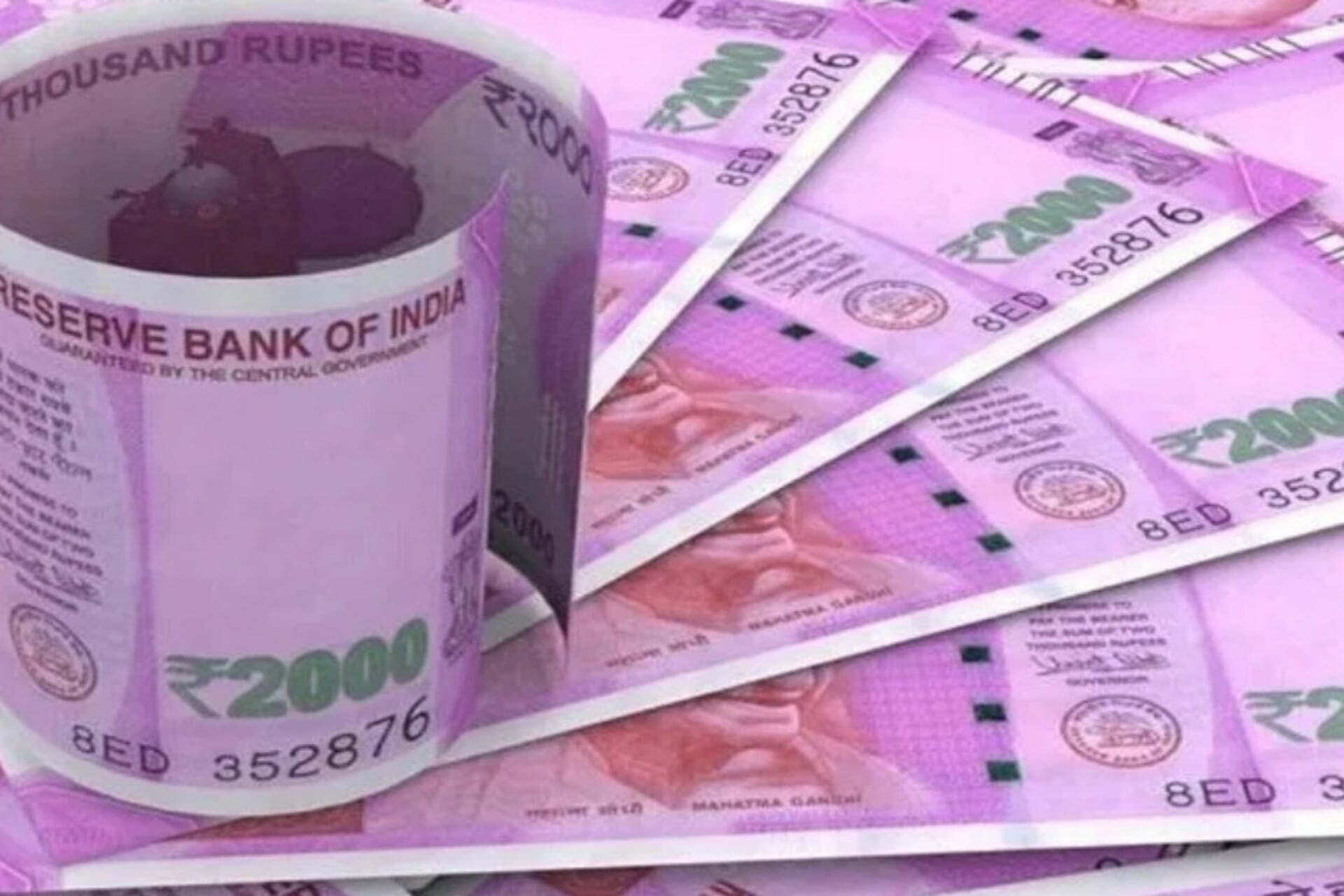RBI has taken back ₹2000 banknotes. They decided to do this because these notes were not used much in everyday transactions. But don’t worry, you can still use them for now. If you have these notes, you can deposit them in your bank account or exchange them at a bank branch. RBI has made special arrangements for seniors, disabled people, and others who need help. You have time until September 30, 2023, to do this.
How ₹2000 banknotes came into existence?
In a bold move aimed at fulfilling the currency demands of the economy after the withdrawal of the ₹500 and ₹1000 banknotes, the Reserve Bank of India (RBI) introduced the ₹2000 denomination banknotes back in November 2016. These high-value notes made their grand entrance with the objective of ensuring the smooth flow of transactions and addressing the nation’s need for currency.
With their distinctive purple hue and advanced security features, the ₹2000 banknotes quickly became an integral part of our monetary system. Their introduction brought a sense of novelty and promise, signaling a new era in financial transactions. The purpose was clear: to bridge the gap created by the demonetization exercise and restore stability to the economy.
A Strategic Move by RBI
As time has unfolded, the Reserve Bank of India (RBI) has embarked on a thoughtful journey to reevaluate the significance of the ₹2000 banknotes within our financial landscape. With meticulous evaluation, the central bank has arrived at a crucial decision—to withdraw these high-denomination notes from circulation. This strategic move serves as a testament to the RBI’s unwavering commitment to fostering a resilient and efficient monetary system, aligning with the guiding principles of the “Clean Note Policy.”
Unveiling the Reasons: Factors Behind the RBI’s Decision
Fulfilling the Original Purpose: Currency Requirements Met
Within the decision to withdraw the ₹2000 banknotes, lies the fulfillment of their original purpose. These high-denomination notes have successfully catered to the currency requirements of the economy, addressing the financial needs that prompted their introduction. With their mission accomplished, the time has come to bid farewell to these notes, marking the dawn of a new era in our monetary ecosystem.
Natural Lifecycle: Surpassing the Estimated Lifespan
Every chapter must come to a close, and so it is with the ₹2000 banknotes. Having gracefully surpassed their estimated lifespan of 4-5 years, it is only fitting to gracefully retire these notes from circulation. By doing so, we make space for the emergence of fresh banknotes, symbolizing the continuous evolution and progression of our currency system.
Limited Usage in Daily Transactions: Circulation Becomes Less Imperative
Amidst the tapestry of reasons, one thread weaves through—the limited usage of ₹2000 banknotes in day-to-day transactions. While they were initially introduced as a convenient high-denomination note, their practicality for routine monetary exchanges has been limited. Furthermore, the availability of an ample supply of banknotes in other denominations ensures that their continued circulation becomes less crucial in meeting the transactional needs of the public.
A Statistical Revelation: From Dominance to Decline
From a statistical perspective, the value of ₹2000 banknotes in circulation has undergone a substantial transformation. The staggering figures, once standing at ₹6.73 lakh crore as of March 31, 2018, have dwindled significantly to ₹3.62 lakh crore as of March 31, 2023, constituting a mere 10.8% of the total notes in circulation. This reduction serves as a vivid contrast to the initial months following their introduction, when ₹2000 banknotes held a commanding presence within the currency landscape.
As these reasons intertwine, the RBI’s decision to withdraw the ₹2000 banknotes is both strategic and well-founded. It signifies a shift towards a dynamic monetary landscape, wherein the currency adapts to the evolving needs and demands of the economy. As we bid adieu to these banknotes, we embrace a future that embraces change, innovation, and progress in the realm of currency.
From Panic to Peace: Don’t Panic as the ₹2000 Banknote is still having its status as legal tender
As the ₹2000 banknotes gracefully step back from the bustling realm of circulation, an important fact emerges—they shall retain their esteemed status as legal tender. This revelation casts a calming aura amidst the waves of change, assuring individuals in possession of these notes that there is no cause for panic or hasty exchanges. The Reserve Bank of India (RBI), in its unwavering commitment to a seamless transition, has meticulously orchestrated a well-planned and structured approach to facilitate the deposit and exchange process.

Smooth Transition: A Step-by-Step Guide to Depositing and Exchanging ₹2000 Banknotes
- Cease Issuance of ₹2000 Banknotes: Banks have been instructed to immediately halt the circulation of ₹2000 banknotes, ensuring that no new notes of this denomination are issued.
- Commencement of Exchange: Starting from 23rd May, 2023, individuals will have the opportunity to exchange their ₹2000 banknotes. The process for depositing these banknotes will remain the same as usual.
- Deposit/Exchange Locations: You can deposit or exchange your ₹2000 banknotes at your own bank branch, any other bank branch, or at one of the 19 Regional Offices (ROs) of the Reserve Bank of India (RBI).
- Flexibility for Account Holders: Account holders may deposit their ₹2000 banknotes into their own bank accounts or choose to exchange them at any bank branch.
- No Restrictions on Deposits: When depositing ₹2000 banknotes into your own bank account, there are no specific restrictions in comparison to the exchange process. You can deposit them as per the usual provisions defined for other types of deposits.
- Maximum Exchange Limit: To ensure smooth operations and avoid disruption at bank branches, there is a maximum limit of ₹20,000 per exchange transaction for ₹2000 banknotes.
- Business Correspondents’ Role: Business correspondents (BCs) are authorized to exchange up to ₹4000 per day for individual account holders. Additionally, banks may increase the cash holding limits of BCs to facilitate the exchange process.
- Mobile Van Services: Banks are considering the possibility of deploying mobile vans to provide deposit and exchange services in remote or unbanked areas, ensuring accessibility for all.
- Special Considerations for Certain Accounts: When depositing ₹2000 banknotes into Basic Saving Bank Deposit (BSBD) or Jan Dhan Yojna accounts, the usual limits for these accounts will apply.
- Priority for Special Cases: Banks will make special arrangements, as feasible, to facilitate the deposit and exchange process for senior citizens, persons with disabilities, and women.
- Deadline for Deposit/Exchange: The deposit and exchange of ₹2000 banknotes will be accepted until 30th September, 2023, allowing sufficient time for individuals to complete the process.
Conclusion
In conclusion, the withdrawal of ₹2000 banknotes by the Reserve Bank of India (RBI) marks a significant step towards a more efficient and adaptable monetary system. With the original objectives of these high-denomination notes fulfilled and their estimated lifespan completed, the RBI has taken a strategic decision to discontinue their circulation. This move aligns with the principles of the “Clean Note Policy” and reflects the evolving needs and demands of the economy. While the withdrawal may bring about changes in our day-to-day transactions, it paves the way for a future that embraces innovation, progress, and a dynamic currency landscape.
Source:
– Reserve Bank of India (RBI) Press release No. 2023-2024/257 on 19th May, 2023
– Notification: RBI/2023-24/32 DCM(Plg) No.S-236/10.27.00/2023-24 on 19th May, 2023
– Image Courtesy: tv9hindi website
Please note that the above information has been sourced directly from the Reserve Bank of India (RBI) Press release and Notification issued on 19th May, 2023.
Frequently Asked Questions (FAQ)
Why are ₹2000 denomination banknotes being withdrawn?
The ₹2000 denomination banknotes are being withdrawn due to several reasons, including the fulfillment of their original purpose, the completion of their estimated lifespan, their limited usage in day-to-day transactions, and the availability of an ample stock of banknotes in other denominations.
What is Clean Note Policy?
The Clean Note Policy is a set of guidelines implemented by the Reserve Bank of India (RBI) to ensure the availability of good quality banknotes in circulation. It focuses on maintaining the overall integrity and standard of banknotes to facilitate efficient transactions.
Does the legal tender status of ₹2000 banknotes remain?
Yes, the legal tender status of ₹2000 banknotes remains intact even after their withdrawal. This means they can still be used for transactions and are recognized as a valid form of currency.
Can ₹2000 banknotes be used for normal transactions?
Yes, ₹2000 banknotes can be used for normal transactions until further notice. However, their circulation may gradually decrease as they are being withdrawn from circulation
What should the public do with the ₹2000 denomination banknotes held by them?
The public is advised to deposit or exchange the ₹2000 denomination banknotes held by them at their own bank branches or any bank branch. They can also visit the 19 Regional Offices (ROs) of RBI for the same purpose.
Is there a limit on deposit of ₹2000 banknotes into a bank account?
There is no specific limit on depositing ₹2000 banknotes into a bank account. Individuals can deposit them in their own bank accounts as per the usual provisions and guidelines applicable to other statutory deposits.
Is there an operational limit on the amount of ₹2000 banknotes that can be exchanged?
To ensure operational convenience and avoid disruptions, there is a maximum limit of ₹20,000 for exchanging ₹2000 banknotes at a time. This limit helps manage the flow of transactions and facilitates smoother operations at bank branches.
Can ₹2000 banknotes be exchanged through Business Correspondents (BCs)?
Yes, Business Correspondents (BCs) may be allowed to exchange ₹2000 banknotes up to a limit of ₹4000 per day for account holders. Banks may also consider increasing the cash holding limits of BCs for this purpose.
From which date will the exchange facility be available?
The exchange facility for ₹2000 banknotes will be available starting from 23rd May, 2023. Individuals can initiate the process of exchanging these banknotes from that date onwards.
Is it necessary to be a customer of the bank to exchange ₹2000 banknotes from its branches?
No, it is not necessary to be a customer of a specific bank to exchange ₹2000 banknotes. Individuals can exchange them at any bank branch, regardless of whether they hold an account with that bank.
What if someone needs more than ₹20,000/- cash for business or other purposes?
If someone needs more than ₹20,000 in cash for business or other purposes, they may need to conduct multiple transactions within the prescribed limits. They can approach their bank to discuss any specific requirements or explore alternative options for fulfilling their cash needs.
Is there any fee to be paid for the exchange facility?
There will not be any specific fee imposed for the exchange facility of ₹2000 banknotes.
Will there be special arrangements for senior citizens, persons with disabilities, etc. for exchange and deposit?
Banks are encouraged to make special arrangements, as feasible, for the exchange and deposit of ₹2000 banknotes by senior citizens, persons with disabilities, and other individuals requiring assistance. These arrangements aim to ensure accessibility and convenience for all customers.
What will happen if one cannot deposit / exchange ₹2000 banknote immediately?
If someone is unable to deposit or exchange ₹2000 banknotes immediately, they can do so within the specified period. The deposit/exchange facility for these banknotes is available until 30th September, 2023, allowing individuals ample time to complete the process.
What will happen if a bank refuses to exchange / accept deposit of ₹2000 banknote?
In case a bank refuses to exchange or accept a deposit of ₹2000 banknotes, the complainant or aggrieved customer may first approach the concerned bank for resolution. If the bank does not respond within 30 days or if the complainant is not satisfied with the response, they can lodge a complaint under the Reserve Bank – Integrated Ombudsman Scheme (RB-IOS), 2021. The complaint can be registered at the Complaint Management System portal of RBI for further redressal of grievances (cms.rbi.org.in).
Explore more details and articles related to finance on our dedicated page created for the purpose. Click Here






2 thoughts on “Breaking News: RBI withdraws ₹ 2000 denomination banknotes from circulation. What to do Now?”